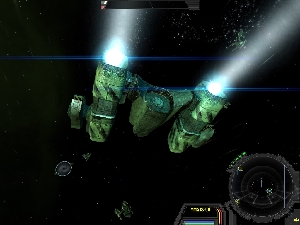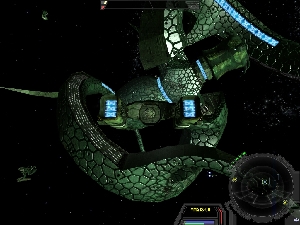All of this is governed from
the cockpit of your primary craft through a series of hot keys and menus that
become intuitive fairly quickly. Extensive auto pilot functions leave you free to
manage your empire if you wish, or you can choose to do everything (including
docking) manually.
 X2 is
not what you'd call a unique design. It's more of an evolutionary step in a long
line of space trading games stretching back to ELITE, released back in 1984 for
the Commodore 64 and the BBC Micro. At the time it was revolutionary, combining
fully 3D wireframe graphics with a sprawling universe, lots of ships
and an entertaining trading model.
X2 is
not what you'd call a unique design. It's more of an evolutionary step in a long
line of space trading games stretching back to ELITE, released back in 1984 for
the Commodore 64 and the BBC Micro. At the time it was revolutionary, combining
fully 3D wireframe graphics with a sprawling universe, lots of ships
and an entertaining trading model.
Versions followed for the Amiga, PC and even the original Nintendo
console. Elite spawned two sequels for the PC, Frontier: Elite II and
Frontier: First Encounters , neither
of which had much success.
Origin's Privateer series and Microsoft's Freelancer
attempted to capture the flavour of the original while adding state-of the art
graphics, as did the predecessor to X2, X: Beyond the Frontier . In addition to these, a whole
host of independently developed 'elite-like' games can be found on the net,
showing the enthusiasm that the original and its descendants evoke.
Now
how does it play?  We'll start with the good stuff because there is rather
a lot of it… fortunately for space trading game fans, the mercantile
aspect of X2: The Threat is done
very, very well.
We'll start with the good stuff because there is rather
a lot of it… fortunately for space trading game fans, the mercantile
aspect of X2: The Threat is done
very, very well.
Egosoft has mixed in a number of
delicious ingredients to make an extremely satisfying whole; call it 'Spaceship
Tycoon' but with guns. Let's look at the positives:
Number one, you can own as many ships
as you can afford. Want a fleet of freighters? You can do it. Want a battle
fleet with a fighter carrier 'Battlestar Galactus' style? You can do it. The 6
races in the game combine to make almost 70 separate ship varieties available,
everything from scouts to carriers to mammoth transports that can move space
stations and asteroids.
While your game persona only
pilots one ship at a time, you control the other ships in your
fleet via a navigational control menu which allows you to set destinations and
waypoints for each ship. Interestingly (and this gives a good example of the 'sci-fi
realism' flavour of the game) the ability to control your ships
remotely can only be achieved by purchasing software upgrades for each ship.
